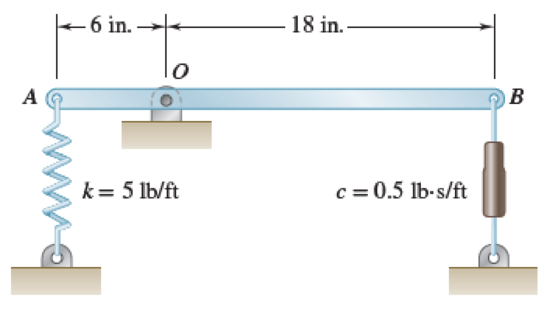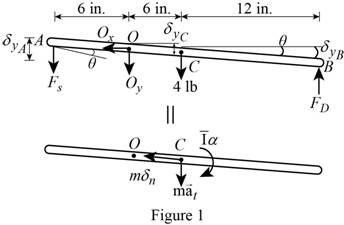
Concept explainers
A 4-lb uniform rod is supported by a pin at O and a spring at A and is connected to a dashpot at B. Determine (a) the differential equation of motion for small oscillations, (b) the angle that the rod will form with the horizontal 5 s after end B has been pushed 0.9 in. down and released.

Fig. P19.165
(a)
The differential equation of motion for small oscillations.
Answer to Problem 19.165RP
The differential equation of motion for small oscillations is
Explanation of Solution
Given information:
The weight of the uniform rod (W) is 4 lb.
The distance between A to O (a) is 6 inch.
The distance between O to B (b) is 18 in.
The spring constant (k) is 5 lb/ft.
The damping coefficient (c) is
The acceleration due to gravity (g) is
Calculation:
Calculate the mass of the uniform rod (m) using the formula:
Substitute 4 lb for W and
Show the free body diagram of the rod as Figure (1).

For small angle, take
Calculate the deflection at the point A
Substitute 6 in. for a.
Calculate the deflection at the point B
Substitute 18 in. for b.
Calculate the deflection at the point C
Substitute 6 in. for a.
Take the moment about O.
Calculate for the spring force
Substitute
Calculate the damping force
Substitute
Calculate the moment of inertia
Substitute 6 in. for a and 18 in. for b.
The angle
Calculate the acceleration
Substitute 6 in. for a and
Substitute
Consider equilibrium.
Take the moment about O.
Substitute 2 for
Substitute
Therefore, the differential equation of motion for small oscillations is
(b)
The angle that the rod
Answer to Problem 19.165RP
The angle that the rod
Explanation of Solution
Given information:
The weight of the uniform rod (W) is 4 lb.
The distance between A to O (a) is 6 inch.
The distance between O to B (b) is 18 inch.
The spring constant (k) is 5 lb/ft.
The damping coefficient (c) is
The acceleration due to gravity (g) is
Calculation:
Consider the equation (3).
Substitute
Solve the above equation.
Since the computed roots are real and distinct.
Write the expression for the general solution for the differential equation as follows:
Substitute 0 for t.
Differentiate the equation (4) with respect to time ‘t’.
Substitute 0 for t.
The above solution corresponds to a no vibratory motion because the roots
Therefore, the angle that the rod
Want to see more full solutions like this?
Chapter 19 Solutions
Vector Mechanics for Engineers: Statics and Dynamics
- An 800-g rod AB is bolted to a 1.2-kg disk. A spring of constant k = 12 N/m is attached to the center of the disk at A and to the wall at C . Knowing that the disk rolls without sliding, determine the period of small oscillations of the system.arrow_forwardTwo springs of constants K1 and K2 are connected in series to a block A that vibrates in simple harmonic motion with a period of 5 s. When the same two springs are connected in parallel to the same block, the block vibrates with a period of 2 s. Determine the ratio K1/K2 of the two spring constants.arrow_forwardA 360-lb motor is supported by springs of total constant 12.5 kips/ft. The unbalance of the rotor is equivalent to a 0.9-oz weight located 7.5 in. from the axis of rotation. Determine the range of speeds of the motor for which the amplitude of the fluctuating force exerted on the foundation is less than 5 lb.arrow_forward
- A machine of mass 75 kg is mounted on springs and is fitted with a dashpot to damp out vibrations. There are three springs each of stiffness 10 N/mm and it is found that the amplitude of vibration diminishes from 38.4 mm to 6.4 mm in two complete oscillations. Assuming that the damping force varies as the velocity, determine : 1. the resistance of the dash-pot at unit velocity ; 2. the ratio of the frequency of the damped vibration to the frequency of the undamped vibration ; and 3. the periodic time of the damped vibration.arrow_forwardA 45-kg motor is bolted to a light horizontal beam that has a static deflection of 6 mm due to the weight of the motor. The unbalance of the motor is equivalent to a mass of 110 g located 75 mm from the axis of rotation. Knowing that the amplitude of the vibration of the motor is 0.25 mm at a speed of 300 rpm, determine (a) the damping factor c/cc(b) the coefficient of damping c.arrow_forwardA 400-kg motor supported by four springs, each of constant 150 kN/m, and a dashpot of constant c = 6500 N·s/m is constrained to move vertically. Knowing that the unbalance of the rotor is equivalent to a 23-g mass located at a distance of 100 mm from the axis of rotation, determine for a speed of 800 rpm (a ) the amplitude of the fluctuating force transmitted to the foundation, (b ) the amplitude of the vertical motion of the motor.arrow_forward
- Two 40-g weights are attached at A and B to the rim of a 1.5-kg uniform disk of radius r = 100 mm. Determine the frequency of small oscillations when β = 60°.arrow_forwardA 14-oz sphere A and a 10-oz sphere C are attached to the ends of a 20-oz rod AC are attached to the ends of a 20-oz rod B Determine the period of small oscillations of the rod.arrow_forwardAn 8-kg uniform disk of radius 200 mm is welded to a vertical shaft with a fixed end at B. The disk rotates through an angle of 3° when a static couple of magnitude 50N.m is applied to it. If the disk is acted upon by a periodic torsional couple of magnitude Tm=60N.m. determine the range of values of vf for which the amplitude of the vibration is less than the angle of rotation caused by a static couple of magnitude Tm.arrow_forward
- A motor of mass M is supported by springs with an equivalent spring constant k The unbalance of its rotor is equivalent to a mass m located at a distance r from the axis of rotation. Show that when the angular velocity of the motor is wf, the amplitude of the motion of the motor is wherearrow_forwardA 6-kg uniform cylinder can roll without sliding on a horizontal surface and is attached by a pin at point C to the 4-kg horizontal bar AB to the 4-kg horizontal bar k= 5 kN/m, as shown. Knowing that the bar is moved 12 mm to the right of the equilibrium position and released, determine (a) the period of vibration of the system, (b) the magnitude of the maximum velocity of bar AB.arrow_forwardA uniform disk of radius r and mass m can roll without slipping on a cylindrical surface and is attached to bar ABC of length L and negligible mass. The bar is attached to a spring of constant k and can rotate freely in the vertical plane about point B. Knowing that end A is given a small displacement and released, determine the frequency of the resulting oscillations in terms of m,L,K,and g.arrow_forward
 Elements Of ElectromagneticsMechanical EngineeringISBN:9780190698614Author:Sadiku, Matthew N. O.Publisher:Oxford University Press
Elements Of ElectromagneticsMechanical EngineeringISBN:9780190698614Author:Sadiku, Matthew N. O.Publisher:Oxford University Press Mechanics of Materials (10th Edition)Mechanical EngineeringISBN:9780134319650Author:Russell C. HibbelerPublisher:PEARSON
Mechanics of Materials (10th Edition)Mechanical EngineeringISBN:9780134319650Author:Russell C. HibbelerPublisher:PEARSON Thermodynamics: An Engineering ApproachMechanical EngineeringISBN:9781259822674Author:Yunus A. Cengel Dr., Michael A. BolesPublisher:McGraw-Hill Education
Thermodynamics: An Engineering ApproachMechanical EngineeringISBN:9781259822674Author:Yunus A. Cengel Dr., Michael A. BolesPublisher:McGraw-Hill Education Control Systems EngineeringMechanical EngineeringISBN:9781118170519Author:Norman S. NisePublisher:WILEY
Control Systems EngineeringMechanical EngineeringISBN:9781118170519Author:Norman S. NisePublisher:WILEY Mechanics of Materials (MindTap Course List)Mechanical EngineeringISBN:9781337093347Author:Barry J. Goodno, James M. GerePublisher:Cengage Learning
Mechanics of Materials (MindTap Course List)Mechanical EngineeringISBN:9781337093347Author:Barry J. Goodno, James M. GerePublisher:Cengage Learning Engineering Mechanics: StaticsMechanical EngineeringISBN:9781118807330Author:James L. Meriam, L. G. Kraige, J. N. BoltonPublisher:WILEY
Engineering Mechanics: StaticsMechanical EngineeringISBN:9781118807330Author:James L. Meriam, L. G. Kraige, J. N. BoltonPublisher:WILEY





